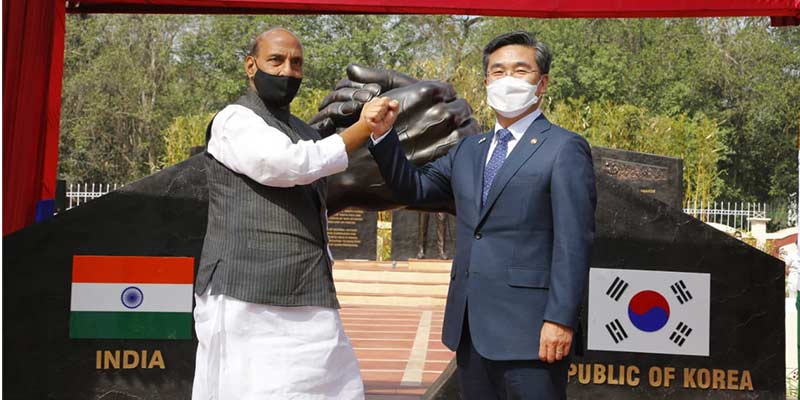- India
- Mar 27
- Mathew Gregory
Indo-Korean Friendship Park inaugurated in New Delhi
• India’s First Indo-Korean Friendship Park was jointly inaugurated by Mr Suh Wook, Hon'ble Minister of National Defence, Republic of Korea and Shri Rajnath Singh, Hon’ble Raksha Mantri, at Delhi Cantonment on 26 March, 2021.
• Located in Delhi Cantonment, the park's significance is not only because of it being a symbol of strong India-South Korea friendly relations, but also as a monument to India’s contributions as part of 21 countries which participated in Korean war 1950-53, under the aegis of the United Nations.
• The park has been developed in joint consultation with Ministry of Defence, Government of India, Indian Army, Delhi Cantonment Board, Embassy of Korea and Korean War Veterans Association of India.
• Spread across a green area of six acres, the park includes an entrance gate beautifully made in Korean style signifying the graceful culture, a jogging track, well landscaped garden and an amphitheatre.
• The park has an imposing handshake artifact standing tall at the entrance bearing flags of India and South Korea.
• The park also has a larger than life statue of General KS Thimayya, a celebrated soldier who led the Indian contingent as Chairman of Neutral Nations Repatriation Commission (NNRC) in Korea headed by India.
• The commission, through Custodian Force of India (CFI), was responsible for gathering unrepatriated prisoners of war into camps which was also India’s first commitment to a UN assignment after independence.
• The five pillars raised in the backdrop of General Thimayya’s statue are embossed with details of operations carried out by 60 Parachute Field Ambulance during the Korean war where they had treated about 1,95,000 cases, and performed about 2,300 field surgeries.
• One pillar also encompasses Nobel Laureate Gurudev Rabindranath Tagore’s narration of Korea as “The Lamp of the East” which was published in Korean daily “Dong-A-llbo” in 1929.
Indo-Korea bilateral trade
• The trade and economic relations between India and Republic of Korea (Korea) have gathered momentum in recent years with annual bilateral trade reaching $21.5 billion in 2018, crossing $20 billion mark for the first time.
• Bilateral trade in Jan-Dec 2020, recorded $16.9 billion.
• The bilateral Comprehensive Economic Cooperation Agreement (CEPA), set in place since 2010, has spurred the trade and investments both ways.
• In 2018, Korea’s investment to India crossed the $1 billion mark for the first time, recording $1.053 billion.
• Korea’s total FDI to India up to September 2020 stands at $6.94 billion.
• Investments from India to Korea are to the tune of approx. $3 billion led by Tata Daewoo, Ssangyong and Novelis.
• India’s share in Korea’s global trade was 1.72% in 2020 and India’s contribution in Korea’s global imports increased from 0.78% in 2001 to 1.05% in 2020.
• India is Korea’s 21st biggest source for imports and 7th biggest export market as of 2020.
• Exports to India moved up the value chain from primary goods to light industrial products, to heavy industrial, high-tech and knowledge-based products.
• One barrier that India faces is Korea’s restrictive policy towards import of primary agricultural products such as fruits and vegetables.
• Major items of India’s export to Korea are mineral fuels / oil distillates (mainly naphtha), cereals, iron and steel.
• Basic materials comprise the bulk of our exports and especially naphtha has emerged as the most important item of India’s export to Korea commanding over 20%.
• Korea’s main exports to India are automobile parts, telecommunication equipment, hot rolled iron products, petroleum refined products, base lubricating oils, nuclear reactors, mechanical appliances, electrical machinery & parts and iron & steel products.
(The author is a trainer for Civil Services aspirants. The views expressed here are personal.)

